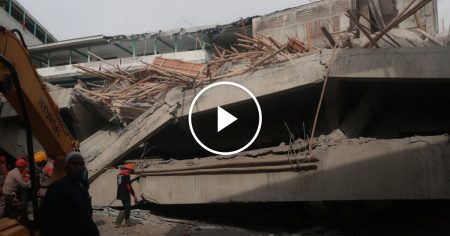Powerful 6.9 Magnitude Earthquake Strikes the Visayan Sea: Impact, Aftershocks, and Regional Response
Devastating Seismic Event Rattles Central Philippines as Authorities Assess Damage
A powerful earthquake measuring 6.9 on the Richter scale struck the Visayan Sea in the central Philippines on Tuesday evening, sending shockwaves through multiple islands and coastal communities. According to data from the United States Geological Survey (USGS), the earthquake occurred at 9:59 PM local time, with its epicenter located approximately seven miles southeast of Calape on Bohol Island. Initially reported as a magnitude 7.0 event, seismologists later revised the measurement to 6.9 following additional data analysis—still categorizing it as a major seismic occurrence with significant potential for structural damage and human impact across the region.
The earthquake’s location in the Visayan Sea—a body of water surrounded by the major islands of Cebu, Negros, Panay, and Masbate—placed numerous densely populated areas within the zone of strong ground shaking. USGS shake intensity maps indicate that areas experiencing an intensity level of 4 or greater (classified as “light” shaking but still strongly noticeable to residents) covered substantial portions of the central Philippines. According to preliminary assessments, the earthquake’s relatively shallow depth contributed to the widespread nature of the tremors, with ground movement felt across multiple provinces including Bohol, Cebu, and portions of Eastern Visayas. Local residents reported furniture moving, hanging objects swinging, and difficulty standing during the main shock, which lasted approximately 30 seconds in the hardest-hit areas.
Understanding Aftershocks: The Continuing Seismic Sequence Following the Main Event
In the hours following the main earthquake, the region experienced multiple aftershocks, which seismologists describe as smaller earthquakes occurring in the same general area as the initial tremor. These aftershocks represent minor adjustments along the portion of the fault that slipped during the primary earthquake, as the earth’s crust settles into a new equilibrium. The USGS has documented several significant aftershocks within a 100-mile radius of the original epicenter, with magnitudes ranging from 3.0 to 5.2—each capable of causing additional alarm and potential structural damage, particularly to buildings already weakened by the main shock.
Seismologists warn that the aftershock sequence could continue for days, weeks, or even years, with the frequency and magnitude of these secondary earthquakes typically decreasing over time. However, experts caution that aftershocks can occasionally equal or even exceed the magnitude of the initial event, posing ongoing challenges for recovery efforts. “The pattern of aftershocks provides valuable scientific data about the fault mechanics and stress redistribution following a major earthquake,” explained Dr. Maria Antonia Bornas, a senior seismologist with the Philippine Institute of Volcanology and Seismology (PHIVOLCS). “However, for residents in affected areas, they represent a continuing psychological and physical threat that complicates recovery and rebuilding.”
Regional Impact: Infrastructure Damage, Evacuation Efforts, and Emergency Response
The earthquake’s impact has varied significantly across the affected regions, with coastal communities in Bohol and eastern Cebu reporting the most substantial damage. In Calape, near the epicenter, local officials documented partial collapses of older concrete structures, extensive cracking in roads, and damage to port facilities. The provincial disaster management office in Bohol activated emergency protocols immediately following the earthquake, establishing evacuation centers for displaced residents and deploying assessment teams to evaluate critical infrastructure. Across the water in Cebu City, the Philippines’ second-largest metropolitan area, authorities reported swaying in high-rise buildings, temporary power outages, and isolated incidents of structural damage, primarily to older buildings not constructed to modern seismic standards.
The Philippine Coast Guard suspended ferry operations between affected islands immediately following the earthquake, stranding thousands of travelers and disrupting supply chains throughout the central Philippines. Meanwhile, the national government, through the National Disaster Risk Reduction and Management Council (NDRRMC), mobilized resources to support local response efforts, including deploying structural engineers to assess critical infrastructure such as bridges, hospitals, and government facilities. “Our primary concern is ensuring public safety while we conduct comprehensive damage assessments,” stated Undersecretary Ricardo Jalad, Executive Director of the NDRRMC. “We are particularly focused on healthcare facilities, schools, and evacuation centers that will be crucial for both immediate response and longer-term recovery.”
Geological Context: The Philippines’ Seismic Vulnerability and the Pacific Ring of Fire
The Philippines’ location along the Pacific Ring of Fire—a horseshoe-shaped belt of seismic and volcanic activity that traces the edges of the Pacific Ocean—makes it particularly vulnerable to earthquakes and volcanic eruptions. The archipelago sits at the junction of several tectonic plates, including the Philippine Sea Plate and the Eurasian Plate, creating a complex network of fault lines throughout the country. The Visayan Sea region specifically has experienced numerous significant earthquakes in recorded history, including a devastating 7.2 magnitude event that struck Bohol in 2013, killing over 200 people and damaging historical churches and infrastructure across the island.
Geologists note that Tuesday’s earthquake appears to be related to movement along the Central Philippine Fault System, a major structural feature running through the Visayan islands. “This earthquake reminds us of the Philippines’ position in one of the world’s most seismically active regions,” noted Dr. Renato Solidum, Undersecretary for Disaster Risk Reduction and Climate Change of the Department of Science and Technology. “While we cannot prevent these natural phenomena, our ongoing efforts in improved building standards, public education, and emergency preparedness aim to reduce their human impact.” The Philippine government has strengthened building codes in recent decades and implemented extensive disaster preparedness programs, though enforcement challenges remain, particularly in rural areas and informal settlements.
Looking Forward: Recovery Challenges, Scientific Monitoring, and Community Resilience
As daylight breaks across the affected regions, authorities are beginning comprehensive damage assessments that will inform both immediate relief efforts and longer-term recovery planning. The Philippine Red Cross has mobilized emergency response teams to provide first aid, psychological support, and basic necessities to affected communities, while international humanitarian organizations stand ready to provide additional assistance if requested by the Philippine government. Telecommunications companies have deployed emergency network support to ensure communication channels remain open, and utility companies are working to restore power and water services in areas where infrastructure was damaged.
Scientists from PHIVOLCS continue to monitor the aftershock sequence closely, updating shake severity maps and providing technical guidance to emergency managers. Real-time seismic data collection not only supports the immediate response but contributes to the scientific understanding of earthquake dynamics in the region, potentially improving future preparedness efforts. Meanwhile, communities across the Visayas—a region known for its resilience through numerous natural disasters—are demonstrating the strength of local social networks as neighbors help one another with immediate needs and emotional support. “Filipinos are unfortunately experienced in responding to natural disasters,” observed Governor Arthur Yap of Bohol Province. “While the damage is significant, the spirit of bayanihan—our tradition of communal unity and cooperation—remains our greatest asset in these challenging times.” As response efforts transition to recovery in the coming days and weeks, this combination of scientific monitoring, government coordination, and community solidarity will be crucial in helping affected areas rebuild stronger and more resilient than before.











